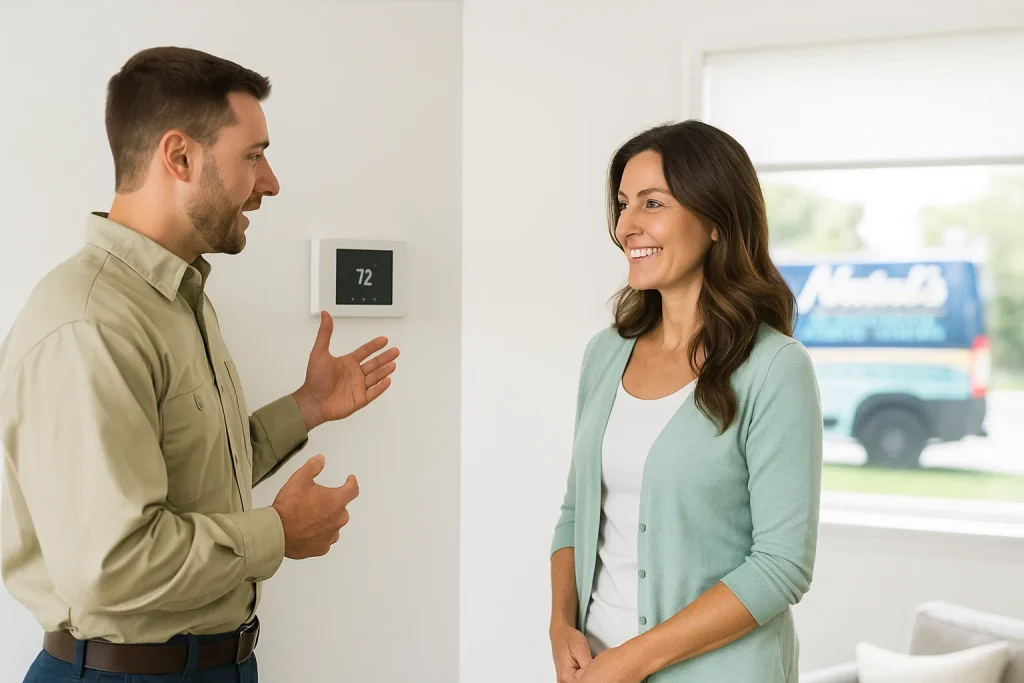As summer winds down and fall approaches, many homeowners start thinking about comfort and energy costs. With fluctuating temperatures and seasonal transitions, your HVAC system will work hard to maintain the perfect indoor climate.
If your current system is older or struggling, upgrading to a high-efficiency HVAC system before fall can save you money, increase comfort, and prepare your home for the cooler months ahead.

Why Upgrade to a High-Efficiency HVAC System
Older HVAC units often lose efficiency over time, consuming more energy while delivering less consistent comfort. A high-efficiency system, on the other hand, uses advanced technology and improved components to heat and cool your home more effectively, reducing energy waste and lowering utility bills.
Key benefits include:
- Lower energy bills – High-efficiency systems use less electricity or gas to maintain your desired temperature, helping you save throughout the year.
- Consistent comfort – These systems provide more even airflow, eliminating hot and cold spots in your home.
- Eco-friendly operation – Reduced energy consumption means a smaller carbon footprint, helping you make an environmentally conscious choice.
Why Fall Is the Perfect Time to Upgrade
Installing a high-efficiency HVAC system in late summer or early fall comes with several advantages:
- Beat the winter rush – Many homeowners wait until the first cold snap to schedule HVAC replacements. Installing your system before peak demand ensures faster service, more installation options, and a smoother process.
- Enjoy immediate savings – Even if temperatures are still warm, a new, efficient system will start lowering your energy bills right away.
- Prepare for comfort all season – A system installed before fall ensures your home is cozy and energy-efficient when the weather turns cooler, avoiding emergency repairs or temporary heating solutions.
How High-Efficiency Systems Save You Money
High-efficiency HVAC units often come with higher SEER2 ratings (for AC units and heat pumps) and AFUE ratings (for furnaces), meaning they convert more energy into usable heating and cooling. This translates into measurable savings on monthly utility bills. Additionally, modern systems often feature:
- Variable-speed compressors or blowers – Adjust energy use based on demand for maximum efficiency.
- Smart thermostats – Optimize temperature settings based on occupancy and schedule, reducing wasted energy.
- Zoned heating and cooling – Condition only the rooms in use, avoiding energy waste in unoccupied spaces.
Combined, these features allow homeowners to enjoy consistent comfort without paying for energy they don’t use.
Additional Considerations
Before upgrading, it’s essential to evaluate your home’s specific needs:
- Ductwork – Leaky or poorly insulated ducts can reduce efficiency. Sealing and insulating ducts ensures your new system performs at its best.
- Proper sizing – A system that is too large or too small will cycle inefficiently and struggle to maintain comfort. A professional evaluation ensures correct sizing for your home.
- Maintenance – Even high-efficiency units require regular maintenance to sustain peak performance. Scheduling seasonal inspections can extend lifespan and maintain savings.
Take Action Before Fall
Upgrading to a high-efficiency HVAC system before fall is an investment that pays off immediately through energy savings, improved comfort, and long-term reliability. By acting now, you avoid the rush, secure the best equipment options, and ensure your home is ready for cooler weather.
Call us today to schedule a consultation or energy assessment. We’ll help you choose the high-efficiency system that fits your home, lifestyle, and budget—so you can enjoy a comfortable, cost-effective fall and winter.
Natal’s Air Conditioning, Plumbing & Electrical. Service Honoring the Golden Rule in North Shore and South Shore communities.
